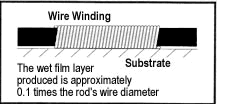Production Coating Rod Overview
Metering rods — also widely known as Mayer Rods, drawdown bars, or metering bars — were invented in 1905 by Charles Mayer, who founded the Mayer Coating Machines Company in Rochester, NY. The company designed and built equipment for manufacturers of carbon and wax papers. The machines demonstrated the superiority of Mayer's patented wire wound rods for applying such coatings. Over time, a variety of innovations and improvements have been implemented for this technology, including the use of stainless, rather than cold-rolled, steel; hard chrome plating for improved wear; and the introduction of double wound, gapped, and formed rods for high viscosity and high solids content coatings.
 The concept behind metering rods is elegantly simple: An excess amount of coating is applied to the web, which is then metered by a stainless steel rod that is tightly wound with a spiral of stainless steel wire. The cavities formed between the wire coils meter the amount of coating which can pass through, and remain on the web. Wet film thickness is predominantly controlled by wire size, as the area of the cavities is directly proportional to the diameter of the wire; the film thickness is roughly one tenth the diameter of the wire.
The concept behind metering rods is elegantly simple: An excess amount of coating is applied to the web, which is then metered by a stainless steel rod that is tightly wound with a spiral of stainless steel wire. The cavities formed between the wire coils meter the amount of coating which can pass through, and remain on the web. Wet film thickness is predominantly controlled by wire size, as the area of the cavities is directly proportional to the diameter of the wire; the film thickness is roughly one tenth the diameter of the wire.
High viscosity and high solids content coatings will tend to reduce wet film thickness, especially at low coating weights. Hardness of the backing roll cover, temperature, and line speed can also have minor effects. With absorptive substrates, rod pressure is also a contributing factor in coating build.
As applied, the coating flows through the cavities in a pattern of parallel stripes; surface tension draws them together, providing a flat, smooth surface. Mayer rods are widely used as a pre-coater for board, as the method produces a smooth finish for final coating. They are also used to apply hot melt wax coatings, as well as in production of release paper, tape, wall coverings, photovoltaic films, window films, and countless other applications. The technique is universal enough to stand as the third most popular coating method, following gravure and reverse roll coating. Coating viscosities of 20 to 1,000 centipoises — and even higher with gapped or double wound rods — can be accommodated at line speeds of up to 3,000 feet per minute in paper mills and 1,000 feet per minute for most converting operations.
Metering rods offer a number of advantages to coaters and converters, including low capital and operating cost; fast changeovers for coating thickness adjustment; precise, consistent, uniform coating thickness control across even wide webs; and simplicity. Compared to blade coaters, Mayer rods offer a more predictable and uniform coating thickness over wide webs, as well as longer wear due to utilization of the entire rod surface, rather than constant metering at a single small edge. Also, loose fibers and other particles accumulate less readily than on blade coaters.
Disadvantages of this technique include limitations on coating viscosity, web speed, and surface tension, which is an important determinant of how rapidly the coating can level itself on the web. The film leveling process, along with drying or curing speed and an increase of hydraulic forces between the web and the rod, act together to establish an absolute “speed limit” for each coating process.
These metering rods are available in diameters from 3/16″ to 1 1/2″: larger rods can improve results somewhat, as they provide a larger nip area; they also offer longer life, as there is more rod surface over which to distribute wear over time. Larger diameter rods also tend to apply a marginally thicker coating due to the increased nip area and the fact that the cavities formed are more parallel to the web direction. On the other hand, large diameter rods are considerably more expensive, as they are fabricated from solid stainless steel. Rod holders, which provide support to keep the rod from bowing, are often used with smaller diameter metering rods.
The rod should rotate against the direction of the web; this reduces wet film splitting. The rod should be mounted so the rotation direction tightens the wire, and should be driven with a variable speed motor to allow optimization of the speed of rotation. Generally, a range of about 25 to 50 RPM will be appropriate for most applications, but the best speed should be determined empirically.